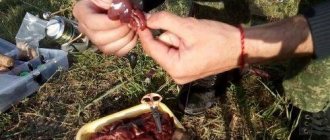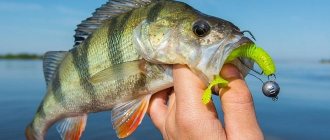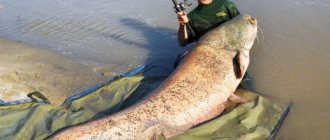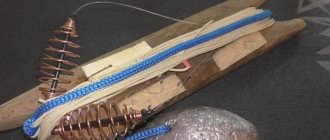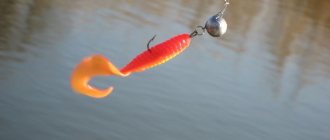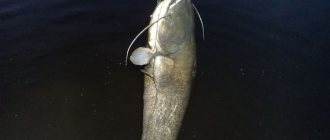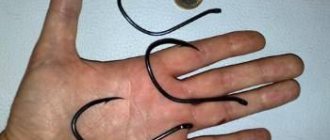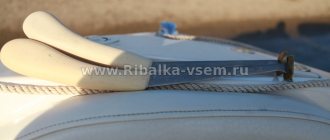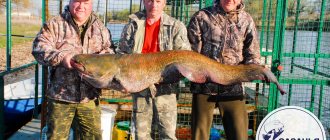This classic method for catching pike and pike perch is not often used for targeted catching of catfish, since there is an opinion that in this way it makes sense to catch the mustachioed giant only in those places where there is a lot of it and during periods when the catfish is most active.
Three Rivers, the confluence of Akhtuba, Mangut and Kharabalyk on the Lower Volga, is almost ideal for jigging catfish throughout the entire period of open water, with the exception of the period of high water (water discharge from the Volgograd hydroelectric station). These places are literally flooded with catfish of all sizes, which is facilitated by a rich food supply and an abundance of riverbed holes - the favorite habitats of the Akhtuba large catfish.
Jig fishing is one of the most sporting and exciting types of fishing for the Volga predator, especially since the struggle when fishing even with a catfish weighing 10-12 kg will give the angler a lot of thrills. What can we say about catfish weighing 40-60 kg, which are regularly caught in Trekhrechye.
Promising fishing areas and searching for catfish in the water area
Many fans of spinning fishing with jigs and large oscillating spoons, when fishing for pike perch and pike in Trekhrechye, often hook catfish, but few people engage in targeted catching in this way.
This is primarily due to the fact that jig fishing is spot fishing, sniper fishing, which presupposes a clear knowledge of the promising place where the active predator is currently standing. Catfish, especially large ones, prefer the biryuk lifestyle and spend most of their time in their favorite lair at the bottom of a riverbed hole near a snag pile. It is all the more difficult to throw bait directly near a hunting catfish, since even on Akhtuba, which is rich in fish, no more than 2-3 medium-sized catfish can coexist in one hole, and even one large one.
Poking bait at random in the presence of such expanses of water is considered a futile task. That’s why you can hardly find pure “catfish horsemen” in Trekhrechye. However, they, catfish catchers on jigs, exist.
Let’s try to figure out what criteria can be used to determine a place that is promising in terms of the presence of catfish and the possibility of jigging.
First of all, it is necessary to determine the parking (bed) sites for catfish in the water area in
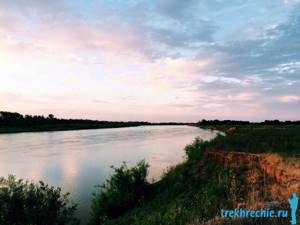
at the moment, and in addition you need to calculate the places of his hunting, which often do not coincide with his permanent habitat. The distance between the parking area and feeding areas can reach hundreds of meters and vary depending on the season and conditions. Moreover, at the moment when the catfish heads to the feeding area, swims, it practically does not feed and is especially careful - it is impossible to catch it at this moment.
In the cold season, the catfish prefers to hunt in the depths near the hole chosen for its den or directly in it, and on warm summer nights it can scour large areas of shallow water in search of crayfish, shells and sleepy fish, including thickets of aquatic plants and coastal snag
Often, especially in summer, catfish settle at the bottom of underwater dumps and the deeper and steeper the dump, the more likely it is to be caught. It is better to start catching catfish with a jig in such places and from a boat. An echo sounder can be very helpful in finding large catfish, but if you have sufficient experience and knowledge of the water area, you can do without it. Usually for such fishing they float a boat along steep yars with drops of 5-10 meters, making casts and a classic jig “step”.
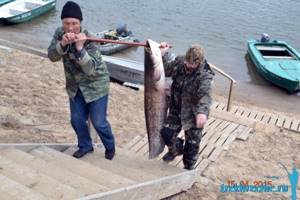
It should be taken into account that catfish, as a rule, do not pursue their prey, but make a single throw towards the passing bait. Therefore, jig fishing in this situation will be precisely targeted: one cast, retrieving and, if there is no bite, cast in the other direction.
If you have the opportunity to quietly anchor or cling to bushes or flooded trees, you don’t have to force the process of fishing a promising area; you can make several sweeps in a fan pattern, while maintaining maximum silence.
Having got your hands on the coastal dumps, you can go out with a jig into the “open sea” - look for catfish in the riverbed holes. This is a delicate matter and requires some experience and intuition. In the water area of Three Rivers on Akhtuba there are many such catfish pits and they are quite long (sometimes up to 100-200 meters in length) due to the strong current. Determining at the beginning of fishing where the catfish currently prefers to be can be quite difficult. A good echo sounder and patience will help. Depending on the season, time of day and weather, the catfish can lie at the very bottom of the hole in a snag, move along the hole, or guard prey at the exits to a shallower place. If it is not possible to immediately identify a catfish using an echo sounder on a rafting trip, all that remains is to try at random.
Peculiarities of behavior of the Akhtuba catfish
The lifestyle of the Akhtuba catfish, as already mentioned, during the period of open water

is a rather cyclical process: lying down - rafting to the hunting place - hunting - rafting - lying down.
In the warm season, catfish usually move to the hunting site in the morning twilight, often splashing their tail on the water, especially if the hunting grounds are shallow or located behind an underwater spit. Trying to catch him while going hunting is useless. It is worth looking in the surrounding area for the feeding area itself. Such a place, at a distance of 20-50 meters from the bedding area, may be a steep yar on a bend, water thickets near an underwater dump, a shallow with an abundance of aquatic vegetation, a backwater or a riffle with a reverse flow. In any case, the catfish will gravitate towards snags, flooded bushes and trees, and other natural obstacles where other fish, frogs or crayfish are concentrated - its main prey.
The catfish usually does not leave its favorite den in the pit, leading a sedentary lifestyle. Even a mustachioed giant disturbed in his own “den” returns after a while to the same place. Therefore, in the event of a catfish disappearing or an empty bite, which often happens, it makes sense to resume attempts to lure it onto a jig bait in the same place after 1-2 days.
Technical and tactical techniques
An echo sounder is a faithful assistant to fishermen. We use an echo sounder to find a hole; it is better if there is a food fish above it. It is difficult to notice a catfish until it begins to move. It is necessary to take into account that catfish are a leisurely, sedate fish and will not chase a fast-swimming bait.
Read: What to use as live bait for catfish
If it is morning or evening dawn, we move the bait using a typical step, but when fishing on a hot day, the following wiring should be used to seduce catfish:
1. After casting, slightly drag the bait, swing the rod and stop the animation for a few seconds. 2. Two jerks with a spinning rod will imitate a wounded fish; we select the slack using a reel. 3. When using a wobbler, it must be deepened so that it moves at a distance of 20-50 centimeters from the bottom. 4. Large areas need to be fished, especially where the bottom topography is complex. The catfish bites so much that to the fisherman the bite appears to be a hook that later comes to life.
The hook must be done sharp and strong in order to pierce the predator's lip. Where there are few holds, you can install doubles and even tees. These hooks will better penetrate the hard mouth of a predator. When fishing for a catfish, you should not give any slack, otherwise it will either break the fishing line or go into a snag. There is no need to rush, you need to wear him down first. If there is strong resistance, loosen the reel clutch.
A good result can be obtained by changing baits. In the summer heat, edible baits spread their scent over long distances, so the chances of catching a trophy increase, because catfish have a good sense of smell. Catfish are active until the evening, when the water temperature is not lower than 12 degrees. The optimal thermometer mark when measuring water is within 20 degrees. It is during this period that the fish are most active.
Collecting jig gear for catfish
Rod
You should not get carried away with oak trolling and sea “sticks”, since jig fishing is still active spinning fishing with artificial bait and you will have to work a lot with the rod.
Sufficiently powerful hard jig spinning rods with a dough weight of up to 65-80 g are perfect. You can also use lighter spinning rods with a test weight of up to 60 g, but they must be of very high quality and able to withstand long-term heavy loads, for example, models of spinning rods for salmon fishing. The point is not that you will have to throw a very heavy bait - the weights of jig heads for Akhtuba with its depths and currents, even with a large windage of the bait, usually do not exceed a weight of 35-45 grams. You just have to choose between the possibility of more or less comfortable work with a spinning rod and the possibility of fishing for very serious prey. For your information, in the summer of 2012, a catfish weighing 90 kg was caught near the fishing village of Trekhrechye, and in June 2013, a handsome fish weighing 70 kg was caught there. Catfish weighing 20-40 kg are caught regularly in Trekhrechye.
Coil
When fishing for catfish, the reel experiences long-term and very serious loads. Models should be chosen that are quite powerful and of high quality, and therefore expensive.
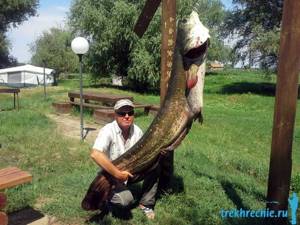
Cheap reels simply quickly break down when working with heavy baits and can fail at the most inopportune moment. Imagine the picture: the line guide or rotor is jammed, and you have a 30 kg carcass walking on a 30-meter cord... You can’t pick out the line with your hands - the braided line with such a load will cut even gloves with Kevlar protection.
It is optimal to take a powerful inertia-free reel of class 3000 and above (Daiwa) or from 4000 according to Shimano.
You can also use multiplier reels, but they are much more expensive and working with them when fishing with jigs requires certain experience and skills.
Fishing line - braided cord
The main fishing line for catfish is traditionally a high-quality braided cord from 0.22 to 0.25 mm in diameter. In Trekhrechye on Akhtuba, when catching catfish by trolling and using donks, they sometimes use cords of even larger cross-sections, but when fishing with a spinning rod using jig tackle, a large diameter of fishing line will be a serious obstacle when casting and retrieving.
A leash is not necessary, but it is useful. In addition to the fact that when fishing for a very long time, the catfish can completely weaken the cord with its jaw brushes, a leash with a tensile strength slightly less than the main cord will save a decent piece of expensive fishing line in case of a tight hook.
Soft jig baits for catfish
When catching catfish with a jig, large silicone vibrotails up to 12-16 cm in length and the same twisters with a wide blade are used - perhaps they optimally imitate a frog.
Large twisters from Berkley and Mann's have proven themselves very well. Their model range includes soft baits made of edible rubber, as well as with attractants - impregnated with a substance that attracts predatory fish. Catfish have an excellent sense of smell and such baits increase the number of bites.
The color and color of the baits is not of great importance, since the catfish, perfectly oriented even in the most muddy water, relies more on the vibration of the water. The general rule is: the clearer and lighter the water, the less bright the color of the bait should be and, conversely, in muddy water with poor lighting, the color of the bait should be brighter.
In any case, it is better to focus on natural colors, and replace the brightness of the bait with a contrasting color, such as RedHeat - a red head with a light or dark body.
As already mentioned, hooking a catfish’s hard mouth is not easy. When fishing for catfish, use large hooks No. 12 and larger, usually doubles. When fishing for catfish, it is important to keep an eye on the sharpening of the sting all the time, since jig fishing goes along the bottom and the points of the hooks often become dull on shells and soil.
Life cycle of a catfish
Catfish are more predisposed to life in rivers, but can also live in standing water. When the water warms up above 12 degrees, the catfish begins to become active. The fish begins to feed fully at a water temperature of 20 degrees. In winter, the predator falls into torpor and spends time in wintering pits. During spawning, which occurs in early July, the female catfish lays about a million eggs. After 5 days the fry appear. At this time, the male guards the clutch, and although he does not feed, he is sometimes caught, rushing at the bait, because he sees it as a threat to his offspring.
At the age of 30 years, a catfish weighs an average of 80 kilograms. Its diet includes animal foods:
- frogs and tadpoles;
- small and large fish;
- leeches;
- crayfish, bivalves;
- bird chicks;
- mice and lemmings caught on the surface of the water;
- fallen insects.
Read: 7 best methods and baits for catching catfish
The catfish feeds on live prey, but if it comes across carrion, it will not disdain.
Techniques for catching catfish using jigging and reeling
As a rule, catfish are caught with a jig from a boat, since there are few places on the Lower Volga where you can cast to a catfish site from the shore. It is more convenient to cast from a boat towards the shallows and pull the bait down into the depths using steps.
In such a situation, the gear is cast no more than 15-35 meters in order to probe the bottom of the dump and the adjacent area. Please note that catfish, hunting at a depth of more than 6-7 meters, are practically not afraid of extraneous noise and the presence of a boat on the surface. Catfish bite occurs under all favorable conditions in two cases:
- the catfish hunts and actively grabs the bait;
- The catfish lies, but cannot miss the “freebie” swimming near its mouth.
The catfish is a rather lazy predator and therefore the retrieve should be done as slowly as possible with short steps. It’s good when, when pulling up, a heavy jig head does not knock, but strikes along the ground. It’s better not to get carried away by sudden jumps of the bait, but to practically drag it along the bottom with pauses.
The catfish bite usually resembles a dull hook, and the bait is slowed down without jerking - it swallows and lies down. After hooking, it is important not to let the catfish immediately go into the snag, near which it usually lives. Therefore, immediately after hooking, you need to force the landing, if the gear allows. It is important to tear the catfish off the bottom as quickly as possible and disturb it. If the catfish lies dead, you can try to stir it up by tapping the rod with the line pulled tight.

When the catfish begins to “walk”, you can no longer rush, letting it get tired, constantly tightening the fishing line. It is better to lift the catfish not with a reel, but to pump it out with a rod - this way you will save the reel, and you will have a clearer grasp of the situation. The friction brake, set to 2/3 of the strength of the cord, is important, since catfish jerks occur even on the “second wind”. The main thing is not to let it lie down again or go under the rubble.
Closer to the surface, you should also expect several unexpected jerks, which should be extinguished in a timely manner by using the rod and the clutch.
Once on the surface, the catfish falls into a stupor for a while and becomes lethargic, but do not relax - after coming to its senses, after 1-5 minutes the mustachioed owner of the river will again begin to resist with redoubled force. It is best to take the catfish into the boat, after bringing it to the side, with a gloved hand by the lower jaw. In this case, the brush (the rough plate on the lower jaw) is caught with the thumb and the rest is pressed under the jaw. This way, you can even lift a catfish up to 30 kg into a boat alone, but still, a partner on such fishing is very desirable to maneuver the boat and help with the lift.
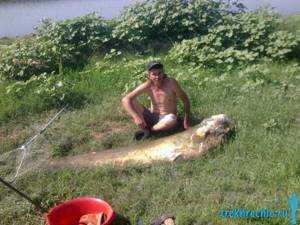
If you catch a very large catfish, more than 40-50 kg, it makes sense to lead it in the water to a sandy stretch or a flat shore. This is where a partner will be indispensable. When lifting and fixing a large specimen, a pair of well-sharpened hooks would be useful. Catfish pulled onto land should be covered with wet burlap or tarpaulin.
Sometimes, in addition to empty bites or hooks, there is also a situation when a catfish that has already been brought to the boat suddenly falls free without effort. This is due to the fact that the catfish grabs the prey tightly, and having a large mouth with hard brushes, it can simply hold a large bait clamped in its mouth for some time and not get caught. Once at the surface, it simply opens its mouth and the bait flies out freely.
And most importantly, take your time and be patient, you must outplay the fish with stamina and composure, because it’s no secret that landing large specimens of this river monster sometimes takes up to 2-3 hours.
How to successfully land a catfish
The fisherman’s desire to lift the catfish into the boat or pull it ashore does not always suit the catfish. A cunning fish will strongly pull the bait into the snags, to the greatest depth, where it will try to confuse or tear the tackle. In order to keep fish out of the windfall, you need to anchor at the entrance to the hole. A tired catfish often lies on the bottom and is very difficult to move. If this happens, you need to pull the line and tap the rod with your palm. After this, the catfish may resume movement.
Many fishermen use a hook to pull catfish ashore or into a boat, but this method is not humane. A catfish pulled up to the shore or boat is taken by the lower jaw with a special glove and turned over with its belly up. After that he stops resisting.
Where to go for catfish on Akhtuba
The best time to catch catfish with a spinning rod is April, June, July and September. If
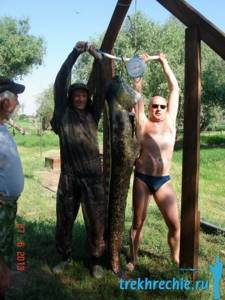
If you want to go fishing in the Astrakhan region in Trekhrechye, then keep in mind that 30 km from the city of Kharabali on a picturesque island there is the Fishing Village “Trekhrechye”, which has its own territory and a flotilla of boats for fishing. In addition to a restaurant, a bathhouse, a bar with billiards, gazebos and sports grounds, at the Trekhrechye base, equipped houses for fishing of various levels of comfort are available for rent, as they say, for every taste and budget.
The Fishing Village welcomes guests from the last week of March to the end of November, and experienced and attentive staff will make your fishing and vacation in Three Rivers on Akhtuba comfortable and unforgettable.
We wish you great fishing trophies!
More
